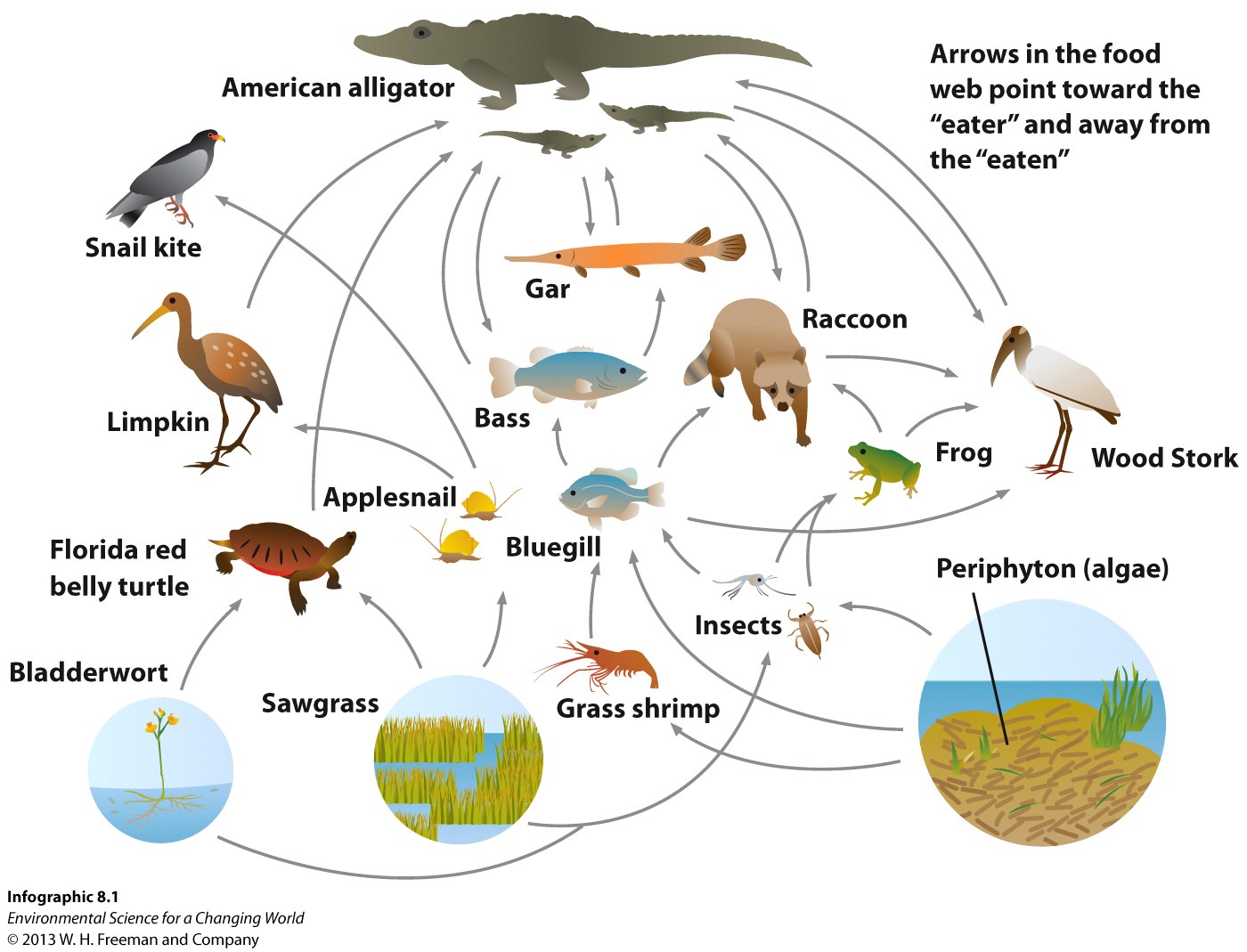Chapter 8. Chapter 8: Community Ecology
How does matter and energy move through ecological communities?

Guiding Question 8.1
How does matter and energy move through ecological communities?
Why You Should Care
Matter can’t be created or destroyed, and in the case of matter in the biosphere, it usually can’t enter or leave. Energy is constantly bombarding the planet as radiation from the Sun, which is then converted to other forms, like chemical energy, through processes like photosynthesis and cellular respiration. So what? First off, ponder this: Every time you breathe in, there’s a good chance you are using at least one molecule of oxygen that has been breathed by just about any human who ever lived. Just now, you could be recycling Julius Caesar’s last breath. The carbon in you has to come from somewhere, too. You may very well have carbon in you that was once part of a Tyrannosaurus. Dinosaurs exhaled CO2, just as we do now, so carbon that was part of their bodies entered the atmosphere. It is quite possible that, after millions of years, one of those carbon dioxide molecules was recently captured out of the atmosphere again by a corn plant by photosynthesis and used to make sugar. If that sugar was then converted into, say, high-fructose corn syrup, you may have just drunk part of a dinosaur in your soda today.
Question Test Your Vocabulary
Choose the correct term for each of the following definitions:
| Term | Definition |
|---|---|
| iIlnXOGiiOdjPDfDuhlEe4/Fii0CmORxxNjGeYXySnYDjbI6NahAA77inVyBuo9owE/ulyhMoQxMzeLonGciH5Jm64BogZ1+1nCK5ax/JwsoczbQLeqt1ul8pIgB7p2lIX/4l/9kWL1pW2W5uMWp68rLAsQINTrp87hNHxvVyfDq+Bp2W9hJylTtrg6c4QPa27cqe795sa9MwE2Gtk0TjatK1m5sn0RUL110aqrPuwB7OTQoUxkWp1Xn8xc8bwnxBxlzLDZOJvY= | A simple, linear path starting with a plant (or other photosynthetic organism) that identifies what each organism in the path eats. |
| D1sI1sIqlxi3sy6xUYPTKbkEZi1UkLoqd9BTnxac74ubdTa+2YOeSpd+ozgLJcexlphsB/KqvzrXCEeTLwS/B1JZpMMrJOdMjlCBHXpi35TI1lmf1PUW83LZqr/ZsoGRRYHAtPqh/cIHlKbFO1+wjVuc8dYUUfYGpTs5s/l2Qhu2MWm3Za3zWPa2ywTcveA6cmG9+8f7SLtbYQE4wRYVwNnYrl3Xr/9YWsr450DOrPWF/V0vbD25lrMgxpzznfpzA0zG9o7tQhI= | An organism that eats other organisms to gain energy and nutrients; includes animals, fungi, most bacteria. |
| k+so7v+06wIYZbz3JPR1yyBT1KZwskdupSv+lncMKWeC+E0HoTiWfomkNdE6UjEFfNT0cXDXGafa5mOm8rk9iGutrn84b0HGn5yrhIGnvFDH9lH6+CpKDva5+gyQnXENnTZOWUaTOEsGDcs7P/lHVDXwAH3iB7lY34z/Karocf/dk0z36dTbR0KKcypT2c1/dQaHvxOyPiK5Pzi1NPGg838xrVuItOtUZupDdSzus5Dols5Ucn5kfKML0u6qlgO1led25OIbPTY= | Organisms such as bacteria and fungi that break down organic matter all the way down to constituent atoms or molecules in a form that plants can take back up. |
| 4ffOviIk/XEBE36uz20SRfdKYB5wQll4rcAoPRgEWLmmTGsVsNkbQOZz4sNTD/59A0XEXYkQYIiXcQyczenEUiIvEsh0J7j9vo4LpcIUWmOJ/0rYAR64Z2fkXUhzVibtdxB3o9psoJG9pK4Cd0kEKzF7DHkbdy6rRPIQqHGIsaJ/3shdS+UINn1d6m+EgbbRZ7G9WZ9M86M3lCBr7HTtmrFk1wiTL/JI7LwT/3RFRA0oYYA6719HyRCCaRm9R19woTzeEAx0E2A= | The species that are particularly vulnerable to ecosystem perturbations, and that, when we monitor them, can give us advance warning of a problem. |
| vqY008bnbZTBbiK765Y1Z/XVO0QZaAjTdFRwmxU4VxrDMQG4TGVnUxKf5U8y1Tz1L4g0VBUDryc3UT/iiMwL4bSORBN4oRHjhNS1ZIZdbLMeFzw91huH85dAIzpoLdCbMkhO5XLDFEes4hcfiquWORa4Cegm7UDD5j7h9BRZA1H82rNvsp21wOsYDa0lf5MKHuPoMF+sttvPklr9MxYFslHQFueYa7itezIyO6YjwOo3uWoeDJ4UgqctjPEfApVMtOBbj8F3SEw= | All of the organisms in a given area plus the physical environment in which they interact. |
| 46yS1fW9WZjBE+2HNcwllOEvbIYj5yM5btBc/tdGJzG+Q1O2SOOC4Cjb4kZ2LnONk+At5CL+mbcuFx6BeGaBtTF7ZpgRvP/6tez6wKxdt7dJ2GG9uhFN0QhX+S0RGu4czt7T/MeqMMtkT6SvrK3Nt0e711VFwVXMfCObibhbTM++pLvFS8X0IPZuvVF2ZGfCnSbGFrMEsKRQ12NM52qGGUmb/LVM0HKz26AY88QQvRcxijVJt6kR/OR6IAze9p3JoocSiMsHtl8= | A measure of the total amount of energy captured via photosynthesis and transferred to organic molecules in an ecosystem. |
| dgkxW47YEWaITISm03lG5GakvSxIHh3QB+9iAJjsM0uD476pUM8R8gpn+PUfayti+5q0973u+w6JqJFKzSlu5WIYah150CkX1NYAV50lR7LcGBhY//umfza0xw90ud5DsmiBIX5xJhePwCHgxfQG3yJB1lKLlWTABCuN+qFCdvLKCBQ8Pz+qZUdwcDYn0p+OAuN/YoLgOuXfRwJ7VCkgVFknqKdj5w6LxxE1GMuK2YlNYTKtC7gg8MqPCw3jAhvN4YYajz6R894= | The study of all the populations (plants, animals, and other species) living and interacting in an area. |
| 0pS0wNDrl4gdWcLWdLCHaliKoUCQ5XmqfAM3+0Yv+G8p8DRoinjAV7Ue6S6OmeAbQJbxVSsWxwWe9QnHmdMlsfzN6GS2+hup0zJU5h1/99jsjBLwyhz2IMhH3NUJU4kkwGG1Scpk+R2VQR7zLvDmcBd157QcrgR/Ycn1hKEqLRiF/AHruzQ6vY9UDdt23lJr24SELw2EaUHZ6lIaDM0dR5d3rsZW52Q/LQaPKcOaqVRiN599zoN3Obt05yKVs/S4Gj7+1SH0xis= | Feeding levels in a food chain. |
| wQNxYlat2C4vzX5AcCyQZ9g3zOGsrSE4NuCxzP/zZu1JkN/bUWMeNll0b44m1P8fNQbGgZ//a/pl0O+PdSz5RxN3Wvxezbn00mytSBEj35x/yjuBup0Wbd4/AHYQyysqgDSD+WkBSRA3VNsz1HCvL6XYbo8fJAUWs+IhkcXzPq2y89P/PAOe2Tpv6H22nn803pYYHOXdQrFK/JIfPZrItxAnSoUCZEPVx3If0T4YQmVi8TwaoJmbGXCjrcdgzcy7k79GdJDC9W4= | Consumers (including worms, insects, crabs, etc.) that eat dead organic material. |
| yq4NJhX7vhBfxUPG56XwjlFrO+RACyhKCRS32XCkFUAvIThM1LecyZ4AgsriadMc6krTXckWmpnIZyEPImGGaTf+KN+F530Bw+wC+UB2v9xj5wWzy9xZepcqY6N7ZfV8bIZT0V5LxLPop9o08nW//b93p960WAbgoiAzwWWxx7m72m6tmodfFL63p+DzrJzHMEjPbuNmUkce4Rns/00khsH2GTpSGaoFPMEpXAEqgDkPB4tLOZ8rc4d9/sp9/Kq9ILpU4ftUr4o= | A linkage of all the food chains together that shows the many connections in the community. |
| ymuxTdJAlKus89FfHKCne9KIQwNENApu+nQVRseI6Nz5A05G1qip0SoKPxGWvRW+I2GH6CddW3rtRNLPJ6V5V8DxrdSIzUwaCOREjhEN6pLYbfjVidJjPK+1SKYzAHWvqlFesckzNfGo8KIoRyAGMrh/YdJ5AM9l2YZhtWqIy/AJois/ZySToHyYz1fw/qyrRQf+RY5FxzRDrpjjttbEfGfzZkRGbFxNQ6qHfODUDJjCA9tp1UI2MlIRExX1ciRfwwFD7YevozU= | A photosynthetic organism that captures solar energy directly and uses it to produce its own food (sugar). |
| x++6HGhniqhlHL/91zfLvkD7EjIYu81LdsDRBRF9kdBPq5K0GoidCK7xF9XdmqK06i8xLIvoPqt2Jc6E5DzlIbnxdce5PcjAWGj6rBNw+CtyksDMLvNteJcHdMCQ0Ya8Fa2WNWVVi3DePtQyEk34ZAVSQxgGi0EinV2upgQ3rB7w6w3FvhJJnDrQHtAVsqJGnPxUV2DnB9GVTrTsEXaudJcznzgBlrvvgqMCZP4UY5zkdT5uCo3/TSN2OQHzRIeJL1/2P7U1P7s= | A measure of the amount of energy captured via photosynthesis and actually stored in the photosynthetic organism. |

Question 8.1
xiEz8roySLCYU20Vl4U9tadR4LD3x+fYnJlkZUlD4mvmk+JqxkPdgY/+uB7ZlxBN5XDvx80KHp3ESHR0jJvOBON7YH1TgIdUgDIQLd2t4c2YBvgEtO6WjMFaUActVjYNKtCULsuD52JkQ7DjY+bHpm8xtFDJaxU4Question 8.2
OaeSdHEXgevlgoBDRGlAc0LQML3G1MSnkGG8A2FOeCQ6N81gydG2+qZK4NwhLXLebHuKeTflRxYKWxHYQdtzkKa8y+CSUoekkvMCjC+wgj+1f+xKGx/Ym4erIJKdNVttLSin2qdW/Lj+h1LJ85av9nmmvQo=Question 8.3
Te/WowHIDRwHo+mq2HG2GA0ljQ7vw/G2+WDRb1cCBkGxZGrC9zLrOJQNLeC9sJthJq0mbQHCFZw7GJhPcv0oXPIZShAeJXZJhm9Z1GdN9guEfIJ08WwsJxtWq+4B9ocozzgrCoy47kAmQw5pG1Pqw7FS8o/voIogViF4Mg==Question 8.4
rUAhshVm3Z3rdnGjXp0f33EKVWGQ6K5yreWI5pU/svup0Fv1cCCVUNmYPGrG+BhyAk1rZB0TxberQ4E2eS9MMw/iGOT9ztnwuhMTx47xQ8ngn8n6IUs3/aW2DCQxFXKqFX3x4Dli0RGJCLU8jdhk18Oss1F8WDPG6pIP5CX1P3Zu+e2a3rr/B3V6UoN8xXRyLW5ZBlCNBsgh82Slc/odL/+9d01aGxi2KnR7JBWNVGPTJYyOPEySx9dPoOUFDoTOLZljl0DQqugC0gCl0mYwzxjU2e1v2oo/2YIZxIgE6d1w9xwjejHAzJjufwCr1FxXH9r8+RcuLu91FDAflJ9ooNml2q5eMM9WCgSlF6VRwUbMwenvg+XQTCog9zIRpSGJQMLSRJII0O51DBAFz6ZN8XjJATeqCQEUyzjNT/IZASYFeIquJ32j1w==Question 8.5
BIR37SawQjBSyq0MDG0GkjvZ+z4OzCO9hVokBUR9POjzLerk2vIDG97WNlAqc3q24Cne/uDNKU1WCPaM7Of4Y7q2imqMnLw09mm+JphTjBV2Fg4e+lEScrU44f6ml1VG
Question 8.6
If a species of fish lives on the zooplankton that eat phytoplankton (algae), it would be considered a rUoq2saBs3vge5p6wAffaalGskPQ90UZzdX9z0lc7fiYUbjRDkZz3xEzj6ljpK3f consumer.
Question 8.7
The level that puts new energy into the food web is the N4AbhTxp2uWLdl/RzZMqoO/FG6yqb80+T/0eJi782vndA8WLdcm6GzFQtwthi9mKknbJY66zfsrGyny4FQ9mEQ==.
Question 8.8
The trophic level that allows matter to return to the food web is the VtkybwZ901GnXbDNQfMjm3TNY0Q8zl5+drK2cwndJ7tN6gn9zQdQdYDzuH//Y75jI6VAR/Rv0A+2S0R/Ol9aLw==.
Question 8.9
If only 10% of energy is transferred between each trophic level, and alligators are quaternary predators, how much of the energy captured by producers in the Everglades actually reaches the alligators? UQ5fZt1qNRe3JasDpercent
Question 8.10
qVKYHwgkN6d7kqRcXYSKxltRHQoa6DMUeDJBOgk3c73wmDWYYLt8pbByNAzIojHK8ahKEoJVy0TxDO+k7HMGdLhkRd9o/CksYtW/EdHJjYUNvGe4NrYBlVtcabymV4pr9LAa4TuGFAvxCatLBB3NlEqDhU98WSwfeGJIRlTSNh1jVZClXCmFRhE/4A6fNLT0JPJu/CwaRbyO4WLt/NK01j9MpURsESn3mOGDv01nddsu4Hon7iMxmdoq+OvJBq2Mbe7MiIQYVKBR017ZQuestion 8.11
Decomposers are typically kOaUtSKOjzQ/2ysvMn+yVFKAAihPlSq05lyjf4X3R3wsDqrjF6O+RAGch1DCB6Kt2ez836VzStIKy2ai96ETHftVI2rlfefBagsD1hQuxk11fNoPfWIhpA==, whereas detritivores are xeVtuJcERR/9zllebVdU3+g4AIoPZVyJ4e64tdgzJWMntEePbFs48WHB624GLwARUcvkvMVv48V/3G/rsjgTN3LmQq0W82RB5IzRmgOhxqj5bp5cS4MThQ==.